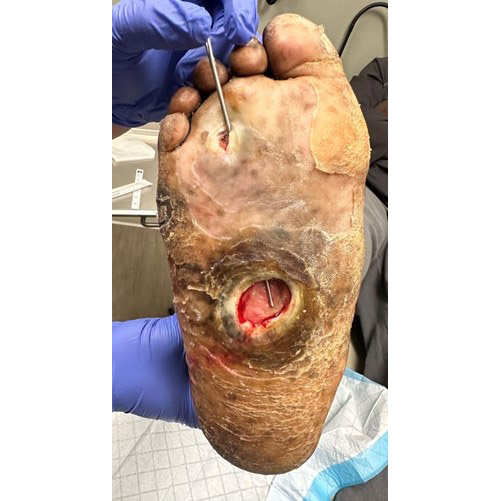For years you have been asking why it is so hard to do the right thing in wound care. I don’t know the answer, but this case is a great illustration of the problem.
Here’s the photo of a patient I recently saw. He has had this diabetic foot ulcer for the past 4 weeks, and below is his treatment history:
- Podiatric visit 4 weeks ago: “Soak daily in full strength household bleach and baking soda.”
- Podiatric visit 3 weeks ago: “Bleach not working – switch to full strength white vinegar with baking soda.”
- Podiatric visit 2 weeks ago: A debridement was billed, but as you can see, it could not actually have been done.
When the patient was referred to me, I was told that I would, “probably decide to apply a Wound Vac.” As you can see in the photo, a probe into the distal wound is visible in the proximal wound. In other words, the actual wound involves nearly the entire plantar foot, and is going to need to be unroofed before any treatment can possibly work.
The problem is not just that physicians don’t do the right thing. In many cases, they clearly have no idea what the right thing is.
–Lee
Lee Ruotsi, MD, ABWMS, CWS-P, UHM
Medical Director, Saratoga Hospital Center for Wound Healing and Hyperbaric Medicine
Saratoga Hospital Medical Group
Saratoga Springs, NY 12866

Dr. Fife is a world renowned wound care physician dedicated to improving patient outcomes through quality driven care. Please visit my blog at CarolineFifeMD.com and my Youtube channel at https://www.youtube.com/c/carolinefifemd/videos
The opinions, comments, and content expressed or implied in my statements are solely my own and do not necessarily reflect the position or views of Intellicure or any of the boards on which I serve.




This to me in the year 20204 is unbelivable, as there is so much information out there. I can still understand if it happens in a country that lacks education and relies on old cultural practices, but here in the united states it is unacceptable.
Not to bash on foot doctors but the fact that this patient was “cared” for by a foot specialist boggles my mind. Yet still, a case like this one is a common occurrence in my wound clinic where I frequently see patients for “a second opinion” for stalled wounds and most are under the care of a foot or wound physician.